Intellitrack Software Certified on Three Unitech Mobile Computers
 IntelliTrack, a leading data collection software manufacturer, and Unitech, a leading manufacturer of AIDC hardware, have partnered to certify Intellitrack software on three Unitech mobile computers: the PA600 WM6.1, the PA968 and the HT680, providing solutions for inventory tracking and warehousing.
IntelliTrack, a leading data collection software manufacturer, and Unitech, a leading manufacturer of AIDC hardware, have partnered to certify Intellitrack software on three Unitech mobile computers: the PA600 WM6.1, the PA968 and the HT680, providing solutions for inventory tracking and warehousing.
IntelliTrack’s inventory management software is designed for application in a variety of settings, and consists of two product lines: Data Management Software (DMS), and Warehouse Management Systems (WMS). Each software package contains a variety of inventory tracking capabilities for organizations of varying size and complexity, and when combined with Unitech mobile computers, provides a solution that paves the way for significantly streamlined operations.
Microscan demonstrates the latest 2D barcode imagers for Direct Part Mark reading at Shanghai Automotive Components Show

Microscan has announced successful results from the recent Automotive Components Shanghai show. During the show, Microscan demonstrated their diverse line of barcode and machine vision products for automotive parts traceability and error proofing processes, including the latest 2D barcode imagers optimized for reading direct part marks.
The Automotive Components exhibition featured suppliers of products such as engine parts, electrical equipment, fuel systems, cooling systems, engine-driven compressors, fans, air conditioners, suspension members, tires, and chassis. At the exhibition, Microscan demonstrated their barcode scanners and 2D barcode imagers, machine vision software, smart cameras, and machine vision lighting.
Local interest in Microscan’s product line was very strong, especially among suppliers recognizing the growing demand for barcode traceability of automotive parts. Of particular interest were Microscan’s QX Hawk and Mobile Hawk imagers, which are optimized to read challenging 2D direct part marks such as Data Matrix. Permanently marked Data Matrix codes are becoming more commonplace to identify and trace components used in automotive and aerospace manufacturing.
More Security for Airports and Flights with Datalogic Bar Code Readers

The Bologna Guglielmo Marconi Airport in Italy chooses Datalogic bar code readers for passenger boarding control
The Bologna Guglielmo Marconi Airport chooses Datalogic Scanning, the world’s leading manufacturer of bar code scanners, to automate the boarding pass control process of passengers with access to the security check zone of the airport.
Applying bar code scanning to this security application ensures access control at the airport is much quicker and safer. The operator in charge of verifying the access of passengers to the boarding area reads the PDF bar code on the boarding pass with the Datalogic PowerScan™ PM8500 handheld bar code reader. The boarding pass can be issued at the check-in desk, printed at home via the Internet or received on the passenger’s mobile phone via SMS or MMS messaging.
The code is then transmitted to the host system, which sends back a message appearing to the reader’s display and an instruction that turns on an LED after the appropriate checks. According to the different colors of the LED (green, yellow or red) the security operator is either authorized to let passengers enter the check-in area for final verification before boarding, or to refuse access due to a cancelled flight or other issues. In the case of access rejection, the reason is explained in the message found on the display of the bar code reader.
Mankato Clinic Achieves Secure, Efficient Prescription Generation With Star Micronics TSP800Rx Printers

Writing prescriptions for patients is a complicated endeavor these days. While some orders for medication and devices may be conveyed to pharmacies by telephone, federal regulations stipulate that controlled substance prescriptions be presented at pharmacies before they are dispensed. Stringent regulations issued recently by the Centers for Medicaid and Medicare Services (CMS) to combat the estimated $5 billion in annual prescription fraud committed throughout the U.S. also come into play; these regulations call for secure prescriptions that cannot be copied, altered or counterfeited.
Bob Norman, director of IT at Mankato Clinic, had such challenges in mind as he shopped the aisles of the Healthcare Information and Management Systems Society (HIMSS) Annual Conference & Exhibition three years ago. One of Minnesota’s largest physician-owned, multi-specialty regional group practices, Mankato Clinic operates eight sites in and around Mankato; its staff includes 80 physicians.
At the time of Norman’s visit to the HIMSS meeting, Mankato Clinic management had already decided to migrate from a manual (handwritten) prescription-issuance system to a printer-based one. “We thought it would be better all around in terms of compliance with all regulations, as well as to make the job a little easier for the doctors,†Norman said. Management had also concluded that using dedicated prescription printers, rather than all-purpose laser jet printers fitted with prescription-generating software, would be their best bet because the latter are more expensive and print prescriptions on 8 ½†X 11†paper instead of standard prescription form.
“We didn’t want to pay more for ‘all-purpose’ printers when all we were going to do was to generate prescriptions,†Norman explained. “We also needed very solid, secure dedicated units with a convenient small footprint, and that would even hang on a wall if we wanted them to.â€
In perusing the HIMMS exhibits, Norman found exactly what he sought in Star Micronics’ TSP800Rx thermal printer. “It fit all our criteria,†he noted. In addition to being designed specifically for the medical industry, it offers durability, a small footprint, and a wall-mounting option.†Even more importantly, Norman said, the TSP800Rx is the only printer available for the medical industry to boast a locking mechanism that deters unauthorized removal of prescription media from the paper chamber.
BarcodesInc Quickens Checkout Lines at Quik Mart Stores
 Quik Mart is one of the largest convenience store chains in Arizona. With a multitude of offerings including fuel, groceries, snacks, and gifts, the checkout lines at Quik Mart were increasingly longer, resulting in frustrated customers and lost revenue. They needed a solution to reduce the customer waiting time and be user-friendly for their employees.
Quik Mart is one of the largest convenience store chains in Arizona. With a multitude of offerings including fuel, groceries, snacks, and gifts, the checkout lines at Quik Mart were increasingly longer, resulting in frustrated customers and lost revenue. They needed a solution to reduce the customer waiting time and be user-friendly for their employees.
Quik Mart turned to a Barcodes Inc expert for a faster Point of Sale solution to keep its checkout lines moving. We offered an omni-directional laser scanner that has been a favorite of many of our convenience store customers. The recommended scanner allowed Quik Mart employees to process transactions quicker and more accurately. Quik Mart now keeps customers moving quickly with these units in all 28 of its locations.
Quik Mart stores has made Barcodes Inc their preferred vendor for their Point of Sale and Automatic Identification and Data Capture requirements.
Free Seagull BarTender 9.3 Service Release Adds Translations, New Features to Barcode Label Software
 Seagull BarTender 9.3 was released on May 14, 2010, with all new features displaying only in English. Service Release 1 (SR1) of version 9.3 was launched on July 20 and added translations of the new features in all 22 of our supported international languages. In addition to the new translations, SR1 includes new EPC data formats for RFID tags and over 100 additional GS1 bar codes.
Seagull BarTender 9.3 was released on May 14, 2010, with all new features displaying only in English. Service Release 1 (SR1) of version 9.3 was launched on July 20 and added translations of the new features in all 22 of our supported international languages. In addition to the new translations, SR1 includes new EPC data formats for RFID tags and over 100 additional GS1 bar codes.
New EPC RFID Data Formats
BarTender 9.3 SR1 supports version 1.4 of EPC’s Tag Data Standard, which adds 7 new EPC RFID data formats:
- GDTI-96
- GDTI-113
- GIAI-202
- GRAI-170
- GSRN-96
- SGLN-195
- SGTIN-198
The above formats can be used with any EPC Gen2 or ISO 18000-6 tag. To view and use the new formats in BarTender, select the Standard RFID pane of the BarTender Toolbox.
New GS1 Bar Codes
The SR1 service release adds over 100 additional GS1 bar code formats. To access them, please select BarTender’s Standard Bar Codes Toolbox pane and open the new, dedicated GS1 folder.
Maricopa County Expands Service and Improves Responsiveness with Wireless
 Maricopa County, which encompasses Phoenix and is home to more than half of Arizona’s population, is the fourth largest county in the U.S. but continues to grow rapidly. Normally, the combination of size and growth would strain county services. But Maricopa has successfully met the challenge with innovation. Since implementing wireless handheld computers from Intermec, Maricopa County has expanded services, improved responsiveness and reduced its labor requirements by at least $40,000.
Maricopa County, which encompasses Phoenix and is home to more than half of Arizona’s population, is the fourth largest county in the U.S. but continues to grow rapidly. Normally, the combination of size and growth would strain county services. But Maricopa has successfully met the challenge with innovation. Since implementing wireless handheld computers from Intermec, Maricopa County has expanded services, improved responsiveness and reduced its labor requirements by at least $40,000.
Maricopa County champions best practices. If one department does something well, it becomes the central provider to all county agencies. Many responsibilities fall on the Maricopa County Public Works Department, which has county-wide responsibility for inventory, asset and document management. The department’s own best practices for providing these services include extensive use of Intermec 750 Series handheld computers running multiple applications from an Intermec Honors Partner highly experienced in the public sector.
“Through our streamlining with the mobile computers we’ve been able to serve more departments without having to hire anyone into our department,†said Maricopa County Public Works Procurement Manager James Baker. “The system is helping improve our accountability and has eliminated human errors.â€
County property is now scanned at receiving, recorded into inventory and the warehouse location automatically documented. The Intermec 750 Series computer also captures the recipient’s signature for proof of delivery when Public Works Department employees deliver items to other county agencies. Workers also uses the handheld computers to manage department assets and to track the documents the county keeps in storage.
Social Security Administration Looks to Reduce Warehouse Labor Costs with RFID
Eligible for Benefits. Limelight is not exactly the Social Security Administration’s usual operating environment. The Administration’s 65,000 employees in roughly 1,500 nationwide offices work relatively quietly helping to deliver benefit payments to some 50 million Americans and serving the general agency needs of millions more.
These days, Social Security Administration (SSA) employees go about their business under the focus of a nation trying to decide how best to steer Social Security’s future. But no matter what that future brings, people will always need help filling out benefit forms, applying for a Social Security number and navigating their way through the system. Spotlight glare or no, administration employees will continue to support the public they serve.
Such service involves millions of copies of forms and publications. The administration stores tons of this material in its main warehouse, an 80,000-square-foot supply building at SSA headquarters in Woodlawn, Md. In 2004, SSA took its own step toward changing its future by initiating a pilot program to track warehouse material wirelessly using radio frequency identification (RFID).
Early tests indicate that a full RFID tracking system could save SSA between 30 and 35 percent in labor costs in its main warehouse. SSA recently began full deployment of the pilot program throughout its main warehouse, to coincide with the rollout of its upgraded warehouse system. Eventually, the 915MHz RFID portals and portable readers will cover all three SSA warehouses in the headquarters complex.
The move came in part from dissatisfaction with manual bar-coded label scanning. John Spencer directs SSA’s Office of Supply & Warehouse Management. He saw how RFID could improve read rates by taking scanning duty out of employee hands and turning it over to an RFID portal.
“There are always problems associated with scanning,†he said. “Getting good reads didn’t occur exactly like we wanted them to. With RFID, we do expect that accuracy to improve.â€
When all system components are in place, workers will no longer need to scan individual boxes of supplies as they move through the warehouse shipping and receiving docks. The main component is the RFID interrogator portal. A portable doorway lined with RFID readers, the portal acts as a tunnel through which workers drive their pallets of materials.
U.S. Navy Saves More Than $10 Million with Wireless Inventory Management System, PHIMS
 An aircraft carrier in the middle of the Indian Ocean is surrounded by 28 million square miles of water. The African coastline lies far off to the west, to the east. The carrier’s deck absorbs the relentless rays of the afternoon sun, at times registering 115 degrees in the shade. Raymond L. Gaiser Jr. has stood on such a deck during his time as an Alterations Program Manager for the Naval Surface Warfare Center (NSWC) Philadelphia. “The heat at times goes right through your shoes,†he said. “It literally blisters you.â€
An aircraft carrier in the middle of the Indian Ocean is surrounded by 28 million square miles of water. The African coastline lies far off to the west, to the east. The carrier’s deck absorbs the relentless rays of the afternoon sun, at times registering 115 degrees in the shade. Raymond L. Gaiser Jr. has stood on such a deck during his time as an Alterations Program Manager for the Naval Surface Warfare Center (NSWC) Philadelphia. “The heat at times goes right through your shoes,†he said. “It literally blisters you.â€
Below deck is another story, thanks to air conditioning. Comfortably cool, the crew can go about its business with hardly a notion of the extreme temperatures above. Should the massive air-conditioning system falter, however, you’d never see a repair order go out so fast.
Gaiser, now a logistics operations manager with NSWC, likely would be the one in charge of filling that order. From his 264,000-square-foot staging facility at the Naval Surface Warfare Center in Philadelphia, he helps to oversee two other staging facilities with a combined parts inventory worth more than $225 million. Parts are assembled into specialized kits that replace, repair or improve any of the systems on Navy ships.
Six years ago, at Gaiser’s suggestion, the NSWC and Anteon Corporation implemented the first phase of a tracking system using mobile computers and printers by Intermec Technologies Corp. known as the Philadelphia Inventory Management System (PHIMS). It is now in its fifth phase of ongoing upgrades and implementations to fine-tune efficiencies. The new system is a vast improvement over the old paper-based way of tracking parts and kits.
Ignorance, Enemy of Bliss
With the new system, inventory accuracy is about 98 percent, up from about 50 percent under the old tracking method. Human error has been virtually eliminated and productivity has increased by 50 percent in the first year. One application of the system, called the Excess Material Improvement Program (EMIP), has saved the Navy more than $5 million. PHIMS paid for itself within the first three years of operation.
Keeping accurate, up-to-date records on some 15,650 item-types means never having to say the three little words, “‘I don’t know’ is absolutely the wrong answer,†Gasier said. “Admirals and Generals want to know where their assets are, and they want to know now.†Tracking these assets conforms to Naval Sea Power 21 Proclamations.
Wisconsin Utility Replaces Leased Lines with Wireless Broadband for More Bandwidth and Operating Efficiencies
The challenge: find a cost-effective connectivity option to support
Automated Meter Reading (AMR) and Supervisory Control and Data Acquisition (SCADA) applications.
A few years ago, Wisconsin Public Service Corporation began exploring using alternate communications to support SCADA and AMR applications. The company was paying in excess of $100,000 per year in the city of Green Bay alone to lease four-wire circuits to connect its AMR head-end to its substations. In addition, the company was using a low bandwidth fixed radio system for SCADA operations for many of the same substations and it soon realized that the 2400-baud connection that the low bandwidth fixed radio system offered would not be enough to support long-term SCADA applications.
To meet the long-term SCADA needs, which included process control applications such as remotely checking power flows and status of the breakers in real-time, the company required additional circuits which would have put its leased line costs in the city of Green Bay alone at more than $200,000 per year.
Wisconsin Public Service immediately began looking for another solution to meet its connectivity needs. Company engineers explored many options. They considered using fiber, but soon discovered that even though the utility already had an extensive fiber network in place, running fiber to its substations in Green Bay would cost upwards of $1 million. The company also looked at options such as frame relay, cellular and satellite links and quickly rejected them, given their low throughput and high ongoing costs.
The solution: a high-speed wireless communications link that provided the right bandwidth for the right cost – and put Wisconsin Public Service in control.
After careful consideration, Wisconsin Public Service took a look at unlicensed wireless solutions. The appeal of these services included ease-of-deployment, low maintenance needs, reasonable cost, high capacity and proven reliability. The opportunity to own and control its own communications network also appealed to the utility.
Wisconsin Public Service reviewed many different unlicensed alternatives and selected Motorola’s Fixed Point-to-Multipoint Canopy® platform. Company engineers chose the Canopy solution based on its low cost, wide coverage, ability to support IP and its superior security. Two other big pluses: The throughput of the Canopy system is not affected by distance and is extremely resistant to interference. Wisconsin Public Service executives considered these characteristics an essential requirement for an unlicensed network. Another very important consideration was the ability to securely implement the solution. This was accomplished through a combination of Canopy security and external third-party tools and products.




